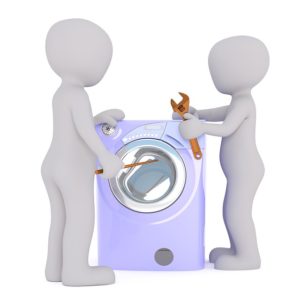 Not all home appliances are equally useful. We use some residential appliances almost every day, while we use other others occasionally. Appliances such as dishwasher, refrigerator, and washer, are some appliances that we use regularly. Any problem with these appliances can upset our daily routine. For instance, if your washer stops working, you may have to wash a pile of dirty clothes by hand, which is a tiring and time-consuming process. To troubleshoot the problem with your machine, it is best to get help from a repairman who is qualified and experienced in doing washing machine repair. If you feel that there is no major problem with your machine and you don’t require the services of a washer technician, you can try the washer repair yourself. However, make sure you take every possible precaution before you start working on your household appliance.
Not all home appliances are equally useful. We use some residential appliances almost every day, while we use other others occasionally. Appliances such as dishwasher, refrigerator, and washer, are some appliances that we use regularly. Any problem with these appliances can upset our daily routine. For instance, if your washer stops working, you may have to wash a pile of dirty clothes by hand, which is a tiring and time-consuming process. To troubleshoot the problem with your machine, it is best to get help from a repairman who is qualified and experienced in doing washing machine repair. If you feel that there is no major problem with your machine and you don’t require the services of a washer technician, you can try the washer repair yourself. However, make sure you take every possible precaution before you start working on your household appliance.
One of the problems you are likely to encounter when using the washer is the timer not advancing. If you plan to troubleshoot the problem yourself, you should check the parts that could be responsible for this problem and repair or replace the damaged part. Some parts that can be responsible for this problem are:
Lid Switch
Most top loaders come with a safety feature known as the lid switch. This switch is usually located below the top lid of the washer. The switch has a pin or projection attached to it which activates the switch when the lid is closed. The switch supplies power to the motor circuits and the timer. Check if the lid switch is activated when the lid is closed. You must also visually inspect the condition of the actuators and levers and make sure they are not sticking or damaged. If the lid switch is activated but there is no power supply to the circuits and the motor, it means that the switch is damaged and must be replaced. To replace the switch, disconnect the power supply to the machine and remove all the wires that are connected to the switch. Once you remove the switch from the machine, check its condition using a multi-meter. Many people avoid replacing the lid switch that is broken or damaged. You should not do this as it is an important safety feature of the washer and can result in serious injury. Get help with this issue from qualified appliance repair professionals.
Timer Motor
Several functions of the washer are controlled by the timer. The timer has several electrical contacts that are operated by a motor or assembly. Some timer contacts control the functions of the timer motor. If the timer of the machine does not advance, it could be due to a problem with the motor or the timer itself. You can check the condition of the timer using a multi-meter. To do this you must have some knowledge of electrical schematics to determine the correct checks. If the timer is working properly, you must check the continuity of the time motor. If there is a problem with the timer motor, you may have to replace the timer assembly, as timer motor may not be available separately.
Water Level Controller
The controller is responsible for controlling the water valve of the washer. When the desired water level is reached, the controller turns off the valve which prevents water from overflowing. If the desired water level is reached but the machine timer does not advance, it may be due to a defective switch that controls the water level. You will need a multi-meter to check the condition of the switch. Before checking the condition of the water level switch, make sure you disconnect the power supply to the machine. Once you disconnect the power supply, remove all the wires that are connected to the switch. Now check the condition of each contact using a schematic diagram.
 Timer Knob
Timer Knob
The knob is attached to the machine’s timer shaft. This knob will turn as the timer advances through the wash cycle. The knob can also be used to activate the wash cycle by pulling out on a lever that activates the timer switch. This plastic knob has a metal insert that is attached to the timer shaft. Normal use of the washer can wear out the knob and prevent it from turning with the timer shaft. When the knob is damaged, it will be difficult for the timer to run to the desired wash cycle. Also, it will prevent the dial from turning with the shaft as the wash cycle advances.
If you plan to replace the faulty dial or knob, make sure you remove the power supply to the house appliance. If power supply is not disconnected, you may inadvertently start the washer which can be a serious health hazard. To remove the timer knob from the machine, you may have to move it in and rotate it in an anti-clockwise direction. Some knobs are covered by cap and have a retaining clip that connects it to the dial. In these machines, you have to remove the cap and the retaining clip to remove the knob from the machine.
Drain Pump
The pump is responsible for removing the water from the tub at the end of the rinse and wash cycle. If there is a problem with the drain pump, the water will not drain from the tub and the washer will not advance to the next portion of the cycle. If you face this problem, you must check the condition of the drain pump. Some electronic washers display a fault code when the water does not drain from the tub. You can use this fault code to identify the exact cause of the problem.
Water inlet Valve
During the fill portion of the wash cycle, the inlet valve supplies both hot and cold water to the washer. The valve has two solenoids that are responsible for opening and closing the valve. If there is a problem during the spin cycle or if the machine stalls during the fill portion of wash or rinse cycle, it could be due to the faulty inlet valve. Before you check the condition of the inlet valve, make sure the inlet hose is not blocked or kinked. Also, make sure the inlet screen is clean. If there is no problem with the hose and screens, you can check the continuity of the solenoids using a multi-meter. This check must be done after you disconnect the power supply to the machine. If the solenoids test out OK, you must check the power supply to the solenoids. This washer service requires a live voltage check which should be performed by a trained appliance service technician. If there is no power supply to the solenoids, you must check the components of water level switch, time, lid and cycle selector switch.
Check for the communities that we service in popular cities:
Austin, Charleston SC, Tucson, Jacksonville FL, Orlando, Miami, Henderson, Charlotte, Indianapolis, San Jose, Richmond, Jackson, Chicago, Portland, Aurora, Olympia, Houston, Lakewood, Providence, Eugene, Manchester, Allentown, Salt Lake City, Cleveland, Everett, Fort Worth, San Francisco, Silver Spring, Detroit, Seattle, Pittsburgh, Philadelphia, Phoenix, Columbus, Oklahoma City, Dallas, Los Angeles, Atlanta, Tacoma, Baltimore, Boston, Provo, Sacramento, Louisville, Nashville, Baton Rouge, St. Louis, Raleigh, Portland, Austin, Colorado Springs, Kansas City, Albuquerque, Virginia Beach, New York City, Middletown, Milwaukee, Las Vegas, Billings, Tampa, New Haven, Tallahassee, Denver, San Diego, Little Rock, San Antonio, Birmingham, Reno City, Newark, Columbia, Omaha, Bowie, Minneapolis
The post How to Fix A Washer That’s Timer Won’t Advance appeared first on OnSite Appliance
This comprehensive guide provides valuable insights into troubleshooting a washer with a timer that won't advance. For complex issues, seeking assistance from experienced appliance repairs service technicians is recommended for safety and efficiency.
ReplyDelete